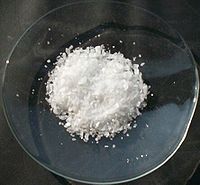
Photo from wikipedia
A study was conducted to evaluate the effects of post-treatment rinsing with water on the inactivation efficacy of acid treatments against Salmonella inoculated onto stem scar areas of two types… Click to show full abstract
A study was conducted to evaluate the effects of post-treatment rinsing with water on the inactivation efficacy of acid treatments against Salmonella inoculated onto stem scar areas of two types of tomatoes. In addition, impact on fruit quality was investigated during 21 days post-treatment storage at 10 °C. A four-strain cocktail of Salmonella enterica (S. Montevideo, S. Newport, S. Saintpaul, and S. Typhimurium) was inoculated onto stem scar areas of grape and large round tomatoes. The inoculated fruits were then treated for 2 min with the following solutions: water, 2% lactic acid +2% acetic acid +2% levulinic acid, 1.7% lactic acid +1.7% acetic acid +1.7% levulinic acid, and 3% lactic acid +3% acetic acid. After treatments, half of the fruits were rinsed with water while another half were not rinsed. Non-inoculated grape tomatoes for quality analysis were treated with the same solutions with and without subsequent water rinse. Results demonstrated that the acid combinations reduced populations of Salmonella enterica on the stem scar area of grape tomatoes by 1.52-1.90 log CFU/fruit, compared with the non-treated control while water wash and rinse removed the bacterium by only 0.23-0.30 log CFU/fruit. On the stem scar of large round tomatoes, the same acid treatments achieved 3.54 log CFU/fruit reduction of the pathogen. The varying response to the acid washes between grape and large round tomatoes seems to be related to the differences in surface characteristics of stem scar areas observed with SEM. Rinsing with water after acid combination treatments did not significantly affect the efficacy of the treatments in either grape or large round tomatoes. Acidic off-odor was detected on fruits treated with acid combination without water rinse 1 day after treatment while water rinse eliminated the off-odor. The acid treatments with and without water rinse did not consistently affect appearance, color, firmness, or lycopene or ascorbic acid contents of tomatoes during 21-days storage at 10 °C. Considering the similarity in antimicrobial efficacy between the fruits with and without water rinse following acid treatments, and the elimination of acidic odor by water rinse, fruits should be rinsed with water after acid treatments. Overall, our results demonstrated that the acids were more effective in inactivating Salmonella on large round tomatoes than on grape tomatoes, and water rinses following acid treatments eliminated the acidic odor without affecting the efficacy of the acids against Salmonella.
Journal Title: International journal of food microbiology
Year Published: 2018
Link to full text (if available)
Share on Social Media: Sign Up to like & get
recommendations!